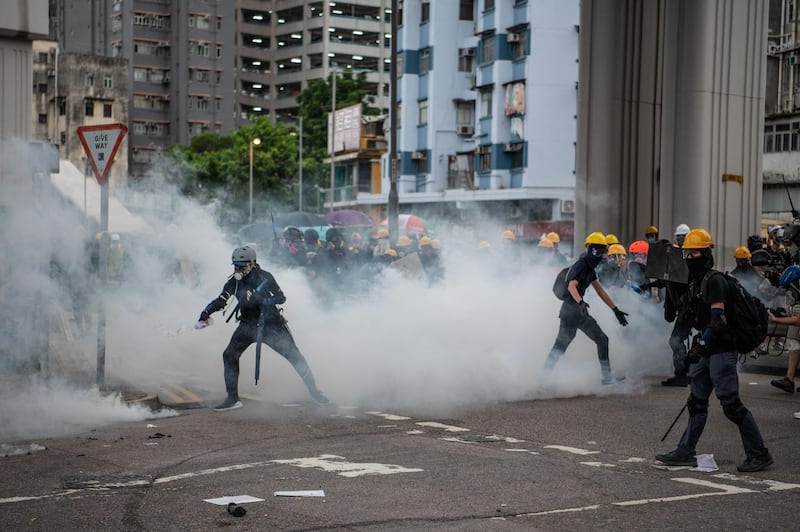Hong Kong pro-democracy protesters defied authorities on Sunday by marching again on the Chinese government’s Liaison Office for the city, where police fired tear gas at demonstrators blocking roads using construction barricades.
The unscripted march started after a short rally against the use of force by police to break up a protest last weekend.
A series of pro-democracy and anti-government rallies and marches has shaken Hong Kong this summer, with many ending in showdowns between police and protesters who occupy streets or throw eggs at and spray-paint slogans on government buildings.
The protests appeared to be getting more organised, as well as more violent.
A march on Saturday, in which demonstrators decried an attack last weekend on marchers by suspected triad gang members, ended in turmoil as riot police waded in to disperse crowds.
On Sunday, activists said by splitting up their marches they hoped to stretch the police.
"The police usually surround us and we have nowhere to go,” protester Edward Ng told Reuters news agency.
“So we adjust our strategy this time. This is much more fluid and flexible."
A gathering in a park in the city's central business district soon spilled onto into surrounding roads and black-clad protesters set off in several directions, clogging up major thoroughfares.
Thousands of people headed east, towards the shopping district of Causeway Bay, while another large contingent headed west, towards the Liaison Office.
The Liaison Office has become a focus of anger of protesters as a symbol of Beijing's increasing control despite guarantees of autonomy under a "one country, two systems" formula, struck when the former British colony returned to Chinese rule in 1997.
Last Sunday, protesters took police by surprise with a swoop on the office, scrawling graffiti and throwing paint bombs at walls, the national emblem and a plaque.
There, hundreds of riot police blocked activists from advancing towards the building, which had been heavily fortified with water-filled plastic barricades. A clear plastic shield had been erected around a national emblem above its front doors.
The protesters massed behind the barriers, with umbrellas pointed forward to shield their identities and ward off any police move to clear them from the street.
"Everyone knows very well that the current Hong Kong government has been controlled by some outside forces, like those in the Liaison Office," an activist surnamed Chan told Reuters.
"Now Hong Kong doesn't even have basic freedom of assembly. We have come here to make a symbolic expression."
Chinese officials deny interfering in Hong Kong and described the vandalism of the Liaison Office as a "challenge" to the sovereignty of the central government, which is sensitive to criticism of the its reaction to the protests.
On Sunday, the Chinese foreign ministry accused an American lawmaker of telling "bare-faced lies and slinging mud" in recent comments he made about the protests.
US Rep Eliot Engel said he is "deeply concerned by the reports of police brutality in response to peaceful protests in Hong Kong." The New York Democrat is chairman of the House Foreign Affairs Committee.
The Chinese statement noted that both President Donald Trump and the mayor of New York had condemned recent incidents in which people had doused New York City police officers with buckets of water.
It noted in contrast that Hong Kong protesters had stormed and vandalised the legislative building and defaced the Chinese national emblem at the Liaison Office.







